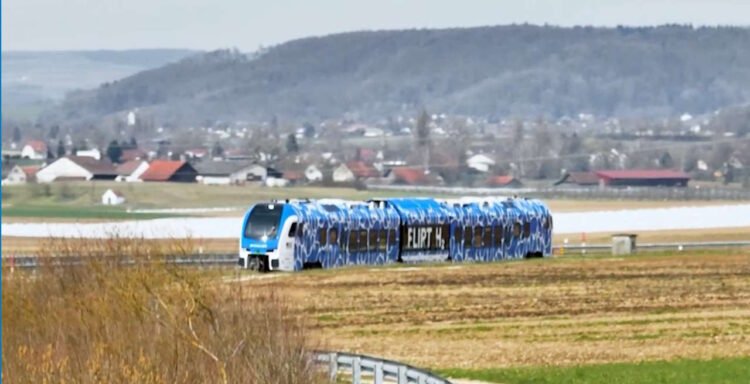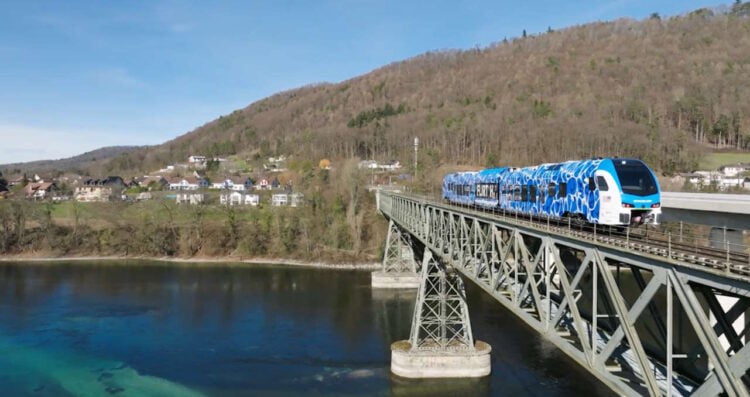A Stadler FLIRT H2 has set a new world record that the Guinness World Records organisation has recognised by travelling 1,741.7 miles without refuelling or recharging.
The remarkable distance has been recorded as the longest distance achieved by a pilot hydrogen fuel cell electric multiple unit passenger train.
Stadler launched the FLIRT H2 at InnoTrans 2022 in Berlin.

Since then, a large number of developments have taken place to integrate fuel cells and hydrogen storage systems into FLIRT trains.
These have been intensively tested, first in Switzerland and recently on a dedicated test ring in Colorado in the United States.
This is a monumental achievement from our entire team and we are very proud to hold another record title.
Dr. Ansgar Brockmeyer, EVP of Marketing and Sales at Stadler
Once the testing programme was nearing completion, Stadler decided to prove the FLIRT’s reliability and capability.
The Guinness World Records adjudication team was invited to observe the FLIRT attempting to set a record for a hydrogen-powered train without the need to refuel or recharge.
The world record attempt took place last Wednesday, 20 March 20, 2024. A team of engineers from Stadler and the ENSCO Transportation Technology Center in Colorado.
The train was driven in shifts throughout the night and the following day until the successful attempt concluded at 5.23 p.m. (MST) last Friday, 22 March 22, 2024.
Altogether, the train travelled 1,741.7 miles in over 46 hours on a single tank of hydrogen.

The record attempt was made at the ENSCO test center in Pueblo, Colorado, where the FLIRT H2 had undergone its type test approval. As part of the world record, detailed records were kept during and after the attempt to ensure that precise and transparent evidence was recorded.
Second World Record for Stadler
This is Stadler’s second Guinness World Records title, as in December 2021, a FLIRT Akku train travelled 224 kilometres in Germany to set the world record for the longest journey with a battery multiple unit in pure battery mode.

In 2023, the Transport Authority of the State of California, Caltrans, ordered four FLIRT H2 trains and earlier this year an option was executed for another six FLIRT H2 trains.
Having four carriages and a power pack in the middle carriage, these will have a higher passenger capacity than earlier FLIRT H2 trains for the San Bernardino County Transportation Authority (SBCTA).
This world record establishes the ideal performance range of our hydrogen version of the best-selling FLIRT Electric Multiple Unit, the FLIRT H2.
This is a monumental achievement from our entire team and we are very proud to hold another record title.
Dr. Ansgar Brockmeyer, EVP of Marketing and Sales at Stadler
Stadler is consistently focusing on the future of rail transportation with alternative drive systems by continuously developing innovative technologies. By using hydrogen as a clean energy source, we are actively contributing to environmental protection and shaping the sustainable and zero emission travel of tomorrow.
Martin Ritter, CEO Stadler US Inc.





Responses
Low energy density of H2 restricts strategic production, storage and distribution to a designed provision of production facility close to point of use and loading to user vehicles. Rail usage routes/circuits need to be selected in conjunction with suitable production site locations, probably at significant rail intersections which may also serve major road vehicle supply points.
I’m not clear if advances in ICE design using rotor pistons etc will deliver close competion vs fuel cell systems on efficiency, overall.
Please can auto-manufacturers of trucks and cars monitor these findings and trial scaled-down vehicles accordingly?
( Battery-powered vehicles will always have an basic infrastructure problem: – each vehicle needs it’s dedicated charging system.
This isn’t compatible with urban dwelling situations where there’s pavements/sidewalks between the highway & the dwelling/office buildings).
55 studies have now confirmed that H2 doesn’t work practically citing fuel cost, maintenance costs, reliability and the fact that already battery trains work. There is no meaningful supply of green H2.
Where already purchased, H2 trains have been withdrawn from service & replaced by battery trains.
If you think battery trains have an infrastructure problem, providing H2 infrastructure is multiple times the cost, so costly in fact that pretty much only Germany, Japan & California have any left in usable numbers!
Still nobody evaluates the full live-circle of produt: electric bateries are not able to be reproducied and are not foreseen to build factories. To dissamble up to 500-1000pcs of batteries is a small factories yearly work. That cost too much for a moment. Even with subsidising. About reprodusing or resuing is still quit, or nobody raises up the question. Many types of bateries are being “stamped”, meaning without ability to take apart after their circle ends, so they will be thrown into a trashyards. So that’s one of the reason why the EV’s seem to be cheap to exploatate for now.
Would be nice to see new Hydrogen trains to operate on smaller branch lines such as in Southwest England, West Wales, South & Southwest Wales, North & Northwest Wale, Northeast England, Northwest England, North of Scotland and Southwest Scotland. And hydrogen trains for London including Chiltern Main Line.
Most hydrogen is produced from hydrocarbons. This means it still requires carbon dioxide capture. The hydrogen fuel cells obviously produce water as by -product so in themselves are cleaner. They will however allow more flexibility and require less infrastructure. It is a negative approach to progress when people use the language of forced to. I prefer the term educated
Like for instance, forced to use a toilet and new sanitation systems (just throw it out the window) forced to educate your children, forced to treat people as equals. The one thing that will destroy us is ignorance and there is certainly an epidemic of that.
More hydrogen power for all transport trucks and cars plant machines as well as the trains. The way to go instead if the electric we appear to being forced into
Absolutely agree, hydrogen presents a much better solution given existing infrastructure and the easiness to convert it to incorporate hydrogen and would be far greener too with no need to mine toxic metals and deal with en-mass expended batteries in the future.
Nobody is forcing battery over H2, the opposite in fact. If it wasn’t for Tesla & the Chinese, the £100s of millions being spent by the gas industry to promote H2 would have had you fooled!
EVs are winning on cost, reliability, reusability, recycling et al.
You do realise that the H2 tank life restricts the service life to 10-14 years I assume?